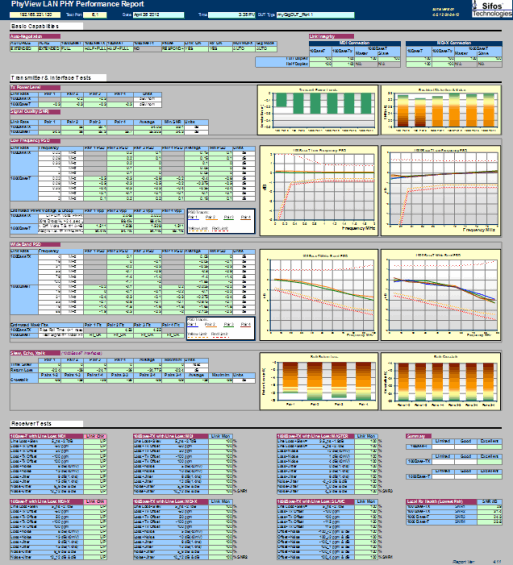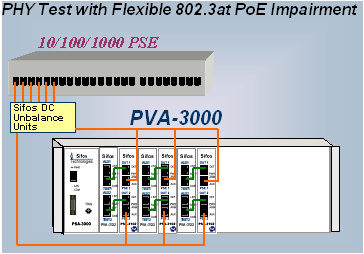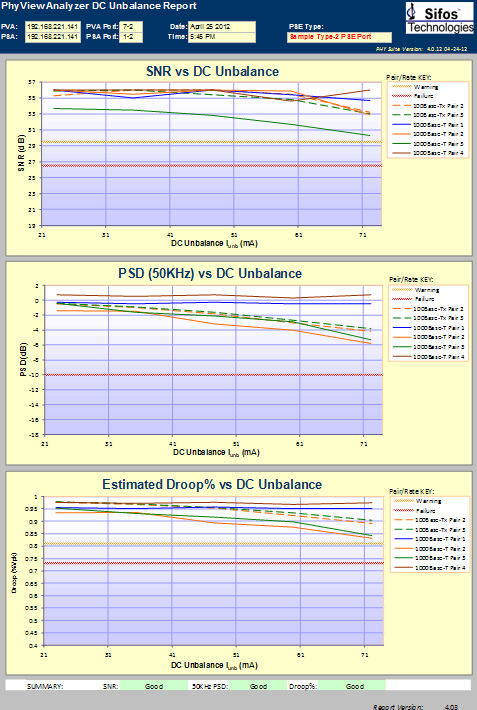PhyView Performance Test Suite
Comprehensive 10/100/1000 PHY Testing Made Easy
Performance Test Suite

Ethernet interface testing has never been easier than the PhyView Test Suite for the PVA-3000. This group of fully automated tests can be automatically sequenced across up to 24 10/100/1000BaseT ports to produce colorful and graphical reports of interface performance. Sequencing and reporting is accomplished with just a few mouse clicks in PVA Interactive software or with a single command in PowerShell PSA. Unlike traditional packet testing, PhyView Performance Tests clearly and independently characterize transmitter, receiver, and physical interface performance in quantitative terms that predict link performance over the full range of possible applications.
Standard (Sequence-able) Tests
- PHY Capabilities (Auto-Negotiation and Link Verification)
- 100BaseTx Transmission Measurements
- 1000BaseT Transmission and Interface Measurements
- 10BaseT Rx Performance: Various Combined Impairments,
MDI & MDI-X Connections - 100BaseTx Rx Performance: Various Combined Impairments,
MDI & MDI-X Connections - 1000BaseT Rx Performance: Various Combined Impairments,
MASTER & SLAVE Timing Modes

DC Unbalance Generation and Testing
With the rapidly increasing population of Power-over-Ethernet PSE’s (Power Sourcing Equipment), one of the most challenging measurements in the domain of Ethernet PHY testing is the relationship between link signal quality and magnetic unbalance associated with large common-mode DC currents. This concern is heightened further by the availability of second generation PSE’s that source 30 watts of DC power on two pairs (one feed, one return). Small deviations from perfect signal balance have the effect of DC biasing magnetic secondary windings which in turn leads to magnetic core saturation. As transformer cores saturate, signal distortions from low frequency attenuation and reduced dynamic range create signal impairment and the potential of impaired link performance.
PVA-3102 test ports may be combined with Sifos PSA-3102 PoE test ports to produce automated analyses of PoE induced signal impairments via the mechanism of DC unbalance. Measurements include multi-pair SNR (non-linear distortion), low frequency PSD (Power Spectral Distortion), and estimated Droop (%). These measurements can be used to assess or qualify the Ethernet magnetics utilized in PSE ports.

The PhyView Performance Test Report
The PhyView Performance Suite produces a Microsoft Excel spreadsheet report that adds graphical presentations of test results and colorized annotations of test limit excursions. Unlike a strict compliance test, many of the parameters captured by the PhyView Performance Suite are evaluated to “soft limits” that assess performance to generally fall into one of three bands: Green (or “Excellent”), Yellow (or “Acceptible”), and Red (or “Marginal”).
The report is structured such that each port tested creates a specific workbook tab dedicated to that particular port. Testing a 24 port switch would therefore cause a 24 tab workbook to automatically pop up upon completion of testing.
The report includes estimations for certain traditional IEEE 802.3 transmission parameters such as Peak-Peak Voltage, Rise/Fall Time, Droop, and Pulse Mask Fit on a per-pair basis. These estimations are derived from detailed correlation studies and analyses carried out by Sifos and other independent test labs.
For those who must perform formal IEEE 802.3 physical compliance testing, PhyView Performance Reports provide an extremely efficient means to select worst-case (or best-case) performing ports to submit to intense testing.
Phyview Analyzer and IEEE 802.3 testing